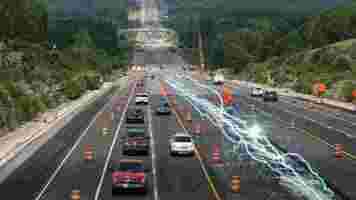Indiana is testing magnetizable concrete for wireless EV charging
Wireless charging might well be the next big revelation in EV infrastructure, and the state of Indiana is the latest to try it out.

The Indiana Department of Transportation (INDOT) and Purdue University have announced their plan to integrate wireless charging into the state’s highways thanks to a special magnetizable concrete, called “magment.”
Developed by the homonymous German firm Magment , this concrete product consists of cement and recycled magnetic particles.
As per the company, the concrete medium has “record-breaking wireless transmission efficiency… up to 95%,” and “standard road-building installation costs, while “enabling universal charging,” among other uses.
The project will be implemented in three phases, expected to begin later this summer.
Phase 1 and 2: The Joint Transportation Research Program (JTRP) of Purdue University will run pavement testing, analysis, and optimization research.
Phase 3: INDOT will construct a 400-meter long magment highway at an undisclosed location, to test the concrete’s capacity to charge heavy trucks, operating at 200 kilowatts and above.
If all the above phases are successful, INDOT will use this technology to build a yet to be determined segment of interstate highway within Indiana.
INDOT claims that such a charging solution would be a “word first,” while Governor Eric J. Holcomb said “[the project] sends a strong signal that Indiana is on the leading edge of delivering the infrastructure needed to support the adoption of electric vehicles.”
It’s reasonable to assume that, in time, wireless charging will be a widespread method, which could solve once and for all issues such as long charging times or range anxiety. The cost required to incorporate it in public roads will be steep, though.
If you’re interested in similar initiatives, you can check out the project of Cornell University and Stanford University .
Do EVs excite your electrons? Do ebikes get your wheels spinning? Do self-driving cars get you all charged up?
Then you need the weekly SHIFT newsletter in your life. Click here to sign up .
Germany has enough lithium for 400M EVs, but extracting it won’t be easy
Germany has struck gold! Well, not gold, but it’s the electric vehicle equivalent. It’s actually discovered a rich vein of lithium, the precious metal that’s a vital ingredient in electric vehicle batteries.

As reported by Reuters , the European nation is sitting on enough lithium to make 400 million electric cars.
The precious metal, geologists say, is thousands of meters deep below the earth’s surface in molten form, beneath the Rhine river. It spans an area 300 km long and up to 40 km wide, in the Upper-Rhine Valley in the Black Forest area of southwest Germany.
That amount of lithium is great news for the German — and wider European — electric car industry.
If the country can find a way to extract the metal in a cost-effective and ethical way, it will no longer have to rely on imported materials, most of which come from Australia, Chile, and China .
That also means the lithium used in European made EVs will have a significantly lower carbon footprint than when it’s transported around the world for final stages of processing and manufacture.
However, extracting the lithium is easier said than done.
One startup eager to extract the lithium deposits told Reuters that it plans to build a number of geothermal power plants, to generate the energy needed for extraction operations.
While it may be able to make the extraction carbon neutral, it will still create significant geological disruption.
Authorities will also likely come up against strong local opposition. While most people are in favor of renewable energy and lower emissions, many aren’t so accepting when it results in local disturbance.
Do EVs excite your electrons? Do ebikes get your wheels spinning? Do self-driving cars get you all charged up?
Then you need the weekly SHIFT newsletter in your life. Click here to sign up .
New global program aims to get 1,000 cities to take climate action by 2030
This article was originally published by Sarah Wray on Cities Today , the leading news platform on urban mobility and innovation, reaching an international audience of city leaders. For the latest updates follow Cities Today on Twitter , Facebook , LinkedIn , Instagram , and YouTube , or sign up for Cities Today News.

Cities across the world have pledged to adopt principles and make “smart investments” to ensure their pandemic recovery plans also bolster climate resilience.
At the two-day virtual Climate Adaptation Summit 2021 yesterday, the mayors of Miami, Paris, and Rotterdam joined the World Resources Institute (WRI), the Global Center on Adaptation, and more than three dozen other cities, governments, and NGOs to launch the new 1000 Cities Act Now initiative.
The global program aims to see comprehensive climate resilience strategies and adaptation measures underway in 1,000 cities by 2030, starting with the first batch of 100.
“As cities recover from COVID-19, smart investments and policies on resilience can create a triple dividend helping cities boost their economies, improving equity, and preparing communities for inevitable climate and health threats,” a joint statement said.
According to the Global Commission on Adaptation’s Adapt Now report , adaptation investments consistently deliver high returns, with benefit-cost ratios ranging from 2:1 to 10:1. Further, the research finds that when compared to traditional investments, adaptation investments often create more jobs, many of which are at the local level.
Five principles
The first cohort of cities will work with an alliance of partners on implementing measures to:
Strengthen and prioritize urban adaptation and climate resilience, with a focus on equity and the most vulnerable and poor communities
Build water-resilient cities and scale nature-based solutions
Advocate for more devolved mandates and funding for cities and advance coordinated leadership to gain political leverage and financing at scale
Enhance knowledge and capacity on urban adaptation and support peer-to-peer collaboration
Coordinate methods, innovations, partners, and investments to maximize impact and accelerate the implementation
The Global Center on Adaptation and WRI will lead on building a 10-year program and growing the 1000 Cities Act Now network. The work will include developing indicators to track progress and adding city resilience data to the Global Covenant of Mayors’ database.
“2021 marks a very important year for climate action,” said Andrew Steer, President, and CEO, WRI. “And this includes in particular adaptation because climate change is already here, and it is hurting people around the world.”
In 2020, wildfires, floods, and storms accounted for more than US$210 billion of loss around the world, according to reinsurance company Munich Re.
Resilience in Rotterdam
Arnoud Molenaar, Chief Resilience Officer, City of Rotterdam, told Cities Today in October that: “COVID-19 is giving us new insights but also a new trigger to focus even harder than before on resilience.”
His team is updating the city’s resilience strategy in light of the pandemic and other learnings over the last four years since it was launched.
As part of its COVID-19 economic recovery plan, Rotterdam recently announced seven-city projects (the ‘Big 7’), which aim to boost the economy and livability, with a focus on green infrastructure and climate adaptation as well as creating jobs and attracting businesses. Other key initiatives that are now being accelerated in Rotterdam include the use of a ‘filter’ tool, which is a set of principles to help the city make decisions, with citizens, about which ideas or actions to prioritize. The leading principle is that programs have to contribute to a more resilient society and economy.
SHIFT is brought to you by Polestar. It’s time to accelerate the shift to sustainable mobility. That is why Polestar combines electric driving with cutting-edge design and thrilling performance. Find out how .